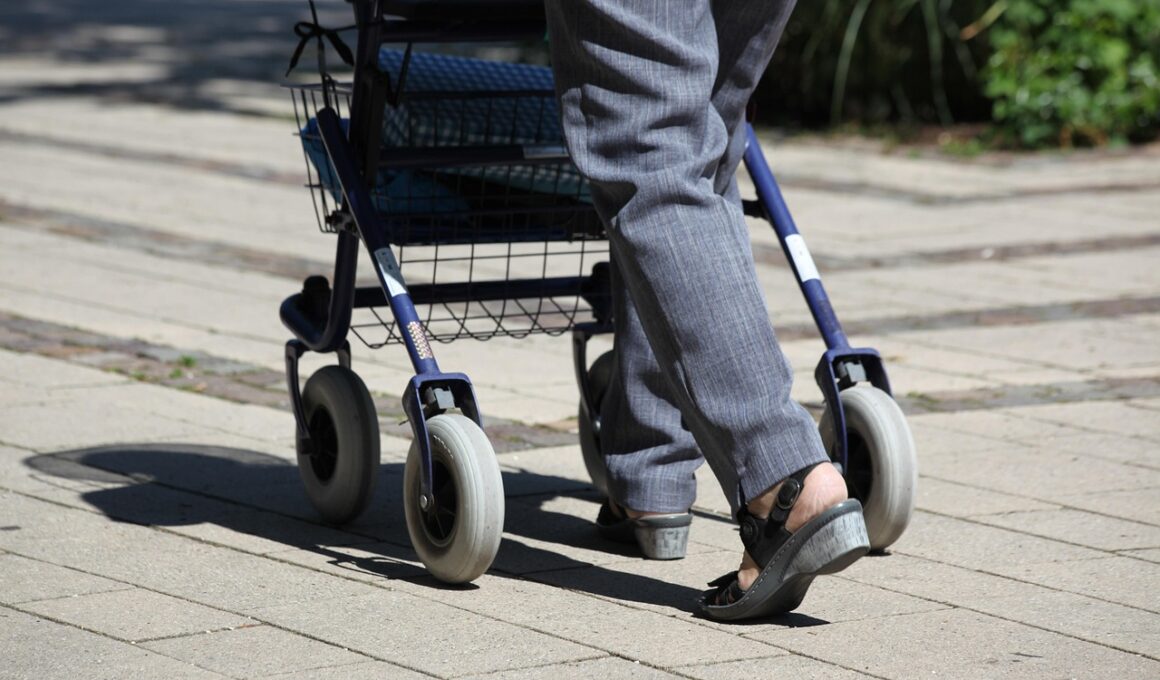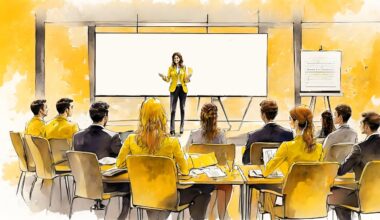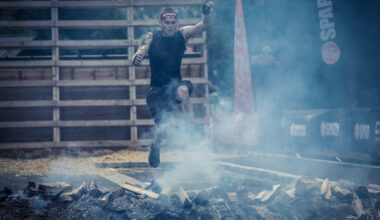Adaptations in Biomechanics with Aging Athletes: Challenges and Solutions
Aging athletes face unique challenges that significantly impact their performance and overall biomechanics. As athletes age, natural physiological changes occur which can alter their movement patterns, strength, and agility. Common issues include decreased muscle mass, reduced joint flexibility, and slower recovery times. These factors play a crucial role in biomechanics, especially when it comes to maintaining optimal performance levels in competitive sports. Understanding the relationship between aging and biomechanics is essential for developing effective training programs that cater to older athletes. Solutions may include integrating strength training, flexibility exercises, and sport-specific movements into their routines. Individualized assessments are vital to identify areas of weakness, thereby allowing tailored interventions. Nutrition also plays a key role in supporting the athletes as they age, ensuring appropriate calorie intake and nutrients for recovery and performance. Therefore, both coaching strategies and scientific understanding are instrumental in addressing the biomechanical challenges faced by aging athletes. Research continues to explore effective strategies, focusing on improving performance longevity and health outcomes, ensuring that aging athletes can continue to participate in sports competitively and safely.
One major consideration in adapting biomechanics for aging athletes involves understanding the effects of joint degeneration. Aging frequently results in osteoarthritis or other joint-related issues that can limit movement. Joints, especially the knees and hips, require attention to prevent discomfort and enhance performance. In training and rehabilitation settings, specific exercises can be used to strengthen the muscles surrounding these joints. Customized movement strategies that avoid undue stress on affected joints are critical in minimizing injuries. Increasing the emphasis on low-impact activities, such as swimming or cycling, helps maintain cardiovascular health while protecting the joints. Additionally, incorporating balance training is essential in maintaining stability and preventing falls, which can lead to severe injuries in older populations. The role of biomechanics not only helps in optimizing performance but also safeguards athlete health as they continue to participate in sports. Trainers and physiotherapists should collaborate to create comprehensive programs that assess individual needs. These adaptations in biomechanics can facilitate sustained athletic involvement among aging athletes, allowing them to enjoy the physical benefits of sport throughout the later years of life.
Strength Training for Aging Athletes
Strength training is a vital component when we talk about adaptations in biomechanics for aging athletes. As people grow older, they often experience sarcopenia, a condition characterized by the loss of muscle mass and strength. This decline contributes to alterations in movement patterns, leading to inefficient biomechanics and increased injury risk. Implementing a progressive strength training program can help mitigate these issues, providing essential support for major muscle groups. They enhance muscular strength, endurance, and balance. Resistance training should be tailored specifically to each athlete’s capabilities and limitations. For instance, incorporating exercises using resistance bands, body weight, or light weights can support joint integrity while promoting muscle activation. Safety should be prioritized throughout this process, emphasizing proper techniques and appropriate warm-ups. Monitoring fatigue levels is crucial, ensuring athletes can recover adequately between sessions. If implemented effectively, strength training not only improves athletic performance but also enhances overall quality of life. Additionally, it can empower aging athletes by increasing confidence in their physical capabilities, which may encourage continued engagement in sports and other physical activities.
In addition to strength training, flexibility remains a critical focus for aging athletes. Age-related changes can lead to a reduction in flexibility, affecting the range of motion in joints and contributing to compensation through improper movement patterns. This can further lead to greater injury risk. Therefore, implementing flexibility training becomes essential in maintaining joint health and optimizing athletic performance. Stretching routines should be developed to target all major muscle groups, with an emphasis on areas that experience significant tightness. Techniques such as dynamic stretching or yoga can enhance muscle elasticity and joint mobility. These practices help aging athletes maintain their performance levels while reducing the likelihood of injuries resulting from limited flexibility. Additionally, incorporating regular flexibility assessments will provide valuable feedback to athletes, motivating them to prioritize their routines. Furthermore, active cooling down post-exercise contributes to ongoing flexibility maintenance. All these components will create a holistic approach to training that recognizes the unique needs and challenges faced by aging athletes. Ensuring flexibility training is integral illustrates the importance of comprehensive program design in sports science.
Nutritional Needs for Aging Athletes
Nutritional strategies play a pivotal role in supporting aging athletes as they navigate the challenges of biomechanics. With changing metabolism and energy requirements, proper nutrition is essential in maintaining athletic performance and health. Consuming a balanced diet focused on essential nutrients, including protein, vitamins, and minerals, can combat muscle deterioration and support energy levels. Special attention should be placed on protein intake, as it is crucial for muscle repair and growth. Research suggests that older athletes may require higher protein intake than their younger counterparts to promote muscle synthesis effectively. Additionally, staying adequately hydrated is often overlooked, but it plays a critical role in performance and recovery. Water intake supports joint lubrication and can prevent fatigue during training sessions. Nutritional interventions should consider the unique training demands of each sport and tailor dietary recommendations accordingly. Coaches and nutritionists should work together with aging athletes to create individualized plans that account for personal health conditions and lifestyles. Providing nutritional education and support can empower these athletes to make informed choices, helping them perform at their best even as they age.
Another vital aspect of training for aging athletes is implementing recovery strategies that minimize the impact of aging on biomechanics. As athletes mature, their recovery times tend to lengthen, requiring a shift in training focus. Adequate rest between sessions allows muscles to repair and adapt, significantly impacting overall performance. This requires a strategic approach to scheduling training sessions, allowing consistent monitoring of fatigue levels. Recovery modalities such as active recovery, hot and cold therapies, and massage can aid in reducing soreness and promoting rehabilitation. Incorporating periodization into training focuses on alternating hard and easy periods of training to manage workload effectively. These strategies may gradually include more rest as athletes age or customize sessions to match their recovery needs. Education surrounding the importance of recovery will empower older athletes to understand their bodies better and respect the healing process. These practices are essential in ensuring that aging athletes remain engaged in their sports for longer while minimizing disruptions resulting from physical limitations. Through these informed recovery strategies, athletes can continue to perform optimally throughout their aging journey.
Conclusion: Embracing the Future of Aging Athletes
As we embrace the future of aging athletes, understanding the role of biomechanics is essential for sustainable performance. Innovative research continues to uncover ways to optimize training approaches, empowering older athletes to prolong their athletic careers. Comprehensive training programs that emphasize strength, flexibility, nutrition, and recovery will address the unique challenges these athletes encounter. A proactive, multidisciplinary approach is crucial that includes coaches, trainers, nutritionists, and physiotherapists collaboratively working towards common goals. It is imperative to listen to the athlete’s feedback, allowing them to shape their training experiences based on their needs and comfort levels. Enhancing knowledge regarding adaptations in biomechanics will foster a supportive environment where aging athletes can thrive. Promoting age-inclusive sports policies will open doors for greater participation. Creating competitive opportunities for older athletes not only enriches their individual experiences but also inspires future generations to stay active and engaged in sports. As academia and sports professionals continue to collaborate, we can ensure that aging athletes receive the support necessary to excel, regardless of age, demonstrating that athleticism can indeed remain a lifelong journey.
In conclusion, adaptations in biomechanics for aging athletes are crucial for ensuring their ongoing success and safety in sports. The emphasis on strength training, flexibility, tailored nutrition, and effective recovery strategies creates a comprehensive approach that supports athletic longevity. By understanding their unique needs and challenges, sports professionals can develop individualized programs that resonate deeply with older athletes. Regular assessments will help monitor progress and adjust training regimens as necessary. Additionally, fostering a supportive community environment can encourage aging athletes to remain active and committed to their fitness goals. Promoting awareness of the impact of aging on biomechanics will ultimately lead to better outcomes in training and performance. Close collaboration among coaches, nutritionists, and physiotherapists is integral in providing holistic support for these athletes. As we embrace advancements in sports science, the potential for aging athletes to continue competing and achieving is greater than ever. By integrating science-backed methodologies, we can redefine longevity in sports, ensuring that aging athletes inspire others while enjoying the physical, mental, and social benefits of athletic engagement.


